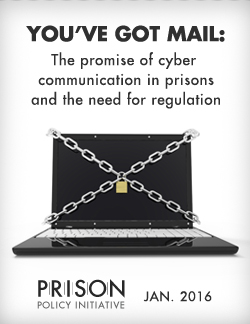Thank you,
—Peter Wagner, Executive Director Donate
You’ve Got Mail:
The promise of cyber communication in prisons and the need for regulation

a Prison Policy Initiative report
by Stephen Raher
January, 2016
Executive Summary
There are many benefits to electronic messaging in correctional facilities, some related to security and others related to the potential for more frequent and faster communication between incarcerated people and their families. But our analysis of the current state of electronic messaging finds that the technology is primed to be just another opportunity for for-profit companies to exploit families and subvert federal and state regulation of phone calls home from prisons and jails.
In this report, we:
- Identify the approximately ten companies that are providing electronic messaging in correctional facilities, many of which provide facilities with other services in addition to electronic messaging.
- Explain how these systems work (such as the distinction between one-way systems and two-way systems).
- Provide the range of fees (anywhere from 5¢ per message to $1.25 per message) typically charged to incarcerated people and their families to send electronic messages.
- Analyze the structure of the electronic messaging industry, such as the fact that electronic messaging is generally offered to correctional facilities as a no-cost add-on option in contracts for bundled services.
- Overall, we find that electronic messaging — which news articles often refer to as "email for prisoners" — is far inferior to the email services available to free-world users because:
- Some electronic messaging systems are "inbound only." With these systems, free-world users are able to electronically send a message to an incarcerated person, but the incarcerated person must respond with a handwritten letter.
- Electronic messaging is usually offered at no cost to correctional facilities, meaning that industry profits come at the expense of incarcerated people and their families who pay user fees.
- Free-world users usually cannot send messages to incarcerated people using their normal email provider; they must go to a specific ICS provider website, log in, and type a message.
The report concludes with 16 recommendations for the Federal Communications Commission, state legislatures, public utility commissions, and correctional administrators, all with an eye toward making electronic messaging a tool that keeps incarcerated people and their families connected rather than a technologically advanced avenue for price gouging.



